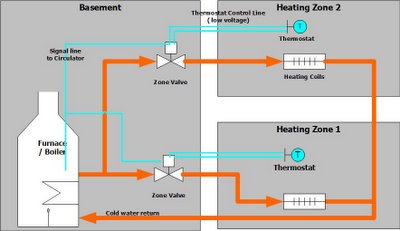
I designed this pair of ottomans ( or is it ottomen ? I never know ) as a solution. The construction itself is pretty basic, but I like how they turned out. I was looking for clean, modern lines, with a piece that was somewhat child friendly .
Construction:
I neglected to take during construction pictures, so my scintillating narrative will have to do ! As penance, I offer to draw up plans for anyone who's interested in making their own !
The construction itself is pretty simple. A box made out of 3/4" MDF board, with simple butt joints held by glue and screws. The base is 1/4" plywood. The Ottoman has storage inside. The top is a 1/2" MDF with a high density 4 foam sheet 4"thick as the seat.
Why all the MDF ? Basically this was one of my first projects that wasn't from a plan and I
 wasn't sure how it would turn out. I wanted to choose the cheapest possible option. If I were doing this again , I'd probably consider something lighter like 3/4" plywood, maybe even OSB. ( oriented strand board, this is the stuff they use for construction, so its relatively cheap) At any rate, it was going to be upholstered, so I knew the look of the wood didn't matter much.
wasn't sure how it would turn out. I wanted to choose the cheapest possible option. If I were doing this again , I'd probably consider something lighter like 3/4" plywood, maybe even OSB. ( oriented strand board, this is the stuff they use for construction, so its relatively cheap) At any rate, it was going to be upholstered, so I knew the look of the wood didn't matter much.Notice the fully hidden cabinet hinges and the anti-slam hinge in the center. I wanted a clean look from the outside, so I didn't want to use something like a regular piano hinge. The anti-slam hinge is a must for all furniture where lids come into the same vicinity as little delicate hands.

The upholstery :
I covered the sides of the table with polyester batting that was about an inch thick, uncompressed. Polyester cloth on the top for easy maintenence. The maroon cloth on the sides is a cross between corduroy and velvet .. its called 'moleskin'. ( Yeah .. You have to pay a visit to a un-macho store like Joanne Fabrics to get the materials. Heads turned as I was probably the only guy in the store.. But the ladies were kind and helpful and only snickered slightly when I referred to the maroon as 'dark red' :-)
All that material, a good hot glue gun -- And you are in business. Finally I got some 1/8" plexiglass and the ottoman becomes a good side table.
Epilogue:
We use both of the Ottomans a lot. One holds my son's toys, the other his books. His first order of business every morning is to ask us to open both up and systamatically pull out everything thats inside !
It was a really simple -- almost crude -- construction. Knowing that the little fingers are safe under the lid and that the padded sides will cushion the little falls -- thats what really makes these pieces for me. I guess sometimes, designing furniture isn't about the furniture.

